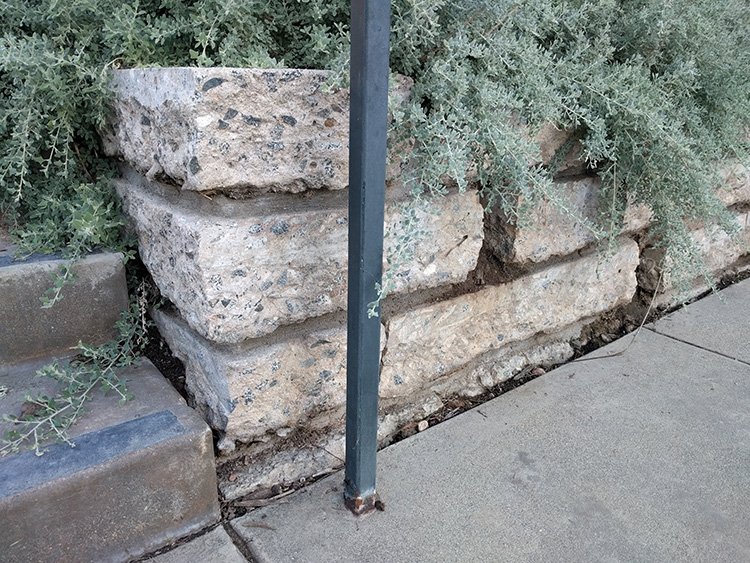Climate Positive Design – Materials for Pathways
A combination of sand-set brick and concrete pavers draw your eye yet define this terraced seating area.
Photo by Miranda Estes
Climate change is on everyone’s mind these days, and it can feel overwhelming. But there are some things you can do in your garden to help. Material choices can make a big impact on the sustainability of your project, without needing to change the broader design features.
‘Embodied carbon’ is a measurement of the CO2 caused by the manufacturing, transportation, installation, maintenance, and disposal of building materials. By choosing more sustainable materials to build with, you can lower your project’s embodied carbon and even your costs.
Wood
Wood boards can be used for walkways or decking, and woodchips can create a soft woodland path. CO2 is stored in wood as the tree grows and remains there as long as the wood isn’t burned. It is important to note that decomposing wood/woodchips will also release CO2, though as long as tree biomass production is as fast as the decomposition rate, or burn rate, the carbon cycle remains in balance.
Here, wood reduces the amount of hard surface while creating a boardwalk feel at this waterfront property.
Using wood in climate positive design:
Build smaller – Build only as much as is really needed; expansive multi-story decks may end up going unused, wasting both space and material
Use smaller lumber sizes – Large lumber comes from older trees and is more expensive; using smaller lumber sizes reduces the number of mature trees being cut down
Avoid tropical hardwoods – deforestation in tropical areas is destroying vital rainforests and contributing to human rights abuse; choose certified and more local lumber or thermally modified woods (a natural and non-toxic way to preserve wood products without using unhealthy pesticides and fungicides) instead.
Bricks and Pavers
Used since antiquity, bricks and other pavers are a classic material. Although the embodied carbon in pavers can be high, this is offset by their low maintenance and long lifespan.
Photo by Miranda Estes
Using bricks and pavers in climate positive design:
Design more efficient paving patterns – herringbone patterns are more stable and longer-lasting, while combining pavers with large gravel joints can reduce the amount of material used.
Use reclaimed bricks or pavers – Bricks have a long lifespan and can even outlast the life of a project; they can easily be recycled. Re-used bricks can also add a historic quality to the design.
Use a sand base instead of a concrete base. This reduces cracking, allows for easier repair, and uses less material while still being strong and durable.
Stone
Stone may be one of humanity’s oldest building materials and can endure with timeless elegance across centuries. Natural stone is abundant in most areas, but should still be selected carefully, minimally processed, and ideally local.
Set on sand and using wide joints, these stone pavers can easily be re-used for a second life.
Photo by Miranda Estes
Using stone in climate positive design:
Re-use existing stone – it can be kept in larger pieces or ground into aggregate.
Use local stone instead of imported – local stone creates both a sense of place and reduces CO2 emissions from transportation.
Design for disassembly – sand-set stone used without mortar or a concrete base can be re-used many times.
Aggregates
Including crushed stone, gravel, sand, and some recycled materials, aggregates are a vital part of many sustainable site features.
Crushed stone steps and pathway.
Photo by Miranda Estes
Using aggregates in climate positive design:
Use instead of rigid materials – aggregate can be used elegantly for patios, walkways, driveways, or just about any other paved surface instead of harder asphalt or concrete
Use reclaimed material for aggregate – existing concrete, asphalt, stone, and even brick can be crushed and re-used as aggregate
Look into non-traditional materials – Crushed oyster shells make a great surface for driveways and paths and uses a waste material; what unconventional materials might be available in your area?
Concrete
Concrete is a very carbon-intensive construction material. Simply by reducing or eliminating concrete, there is opportunity for big carbon savings.
Used in a wall, broken concrete or “urbanite” is carefully laid to create a one-of-a-kind feature.
Photo by Meghan James
Using concrete in climate positive design:
Choose another material – use local stone pavers, aggregates, or wood instead of concrete.
Recycle existing concrete – re-use concrete pavements by grinding into aggregates or re-using as “urbanite” to build a wall; this saves material and prevents it from being sent to a landfill.
Use concrete with cement substitutions – Portland cement has high embodied carbon; choosing cement substitutions (such as fly ash, clay, or slag, among many more being researched today) can re-use industrial waste, reduce air pollution, and improve the concrete’s performance.
These are just a few of the many ways that material choices can help your project be climate positive. Talk with your designer about your options and you can enjoy a landscape which is beautiful, functional, and helps address climate change.






